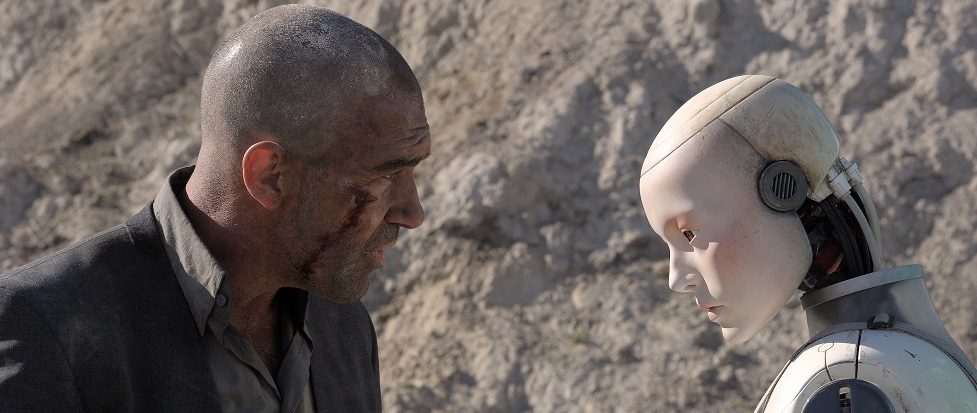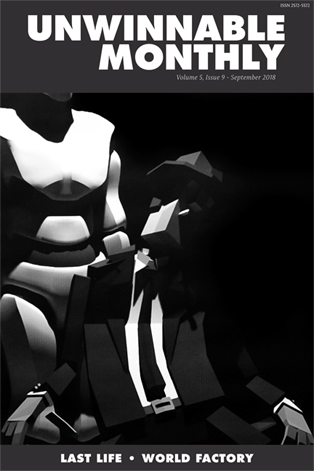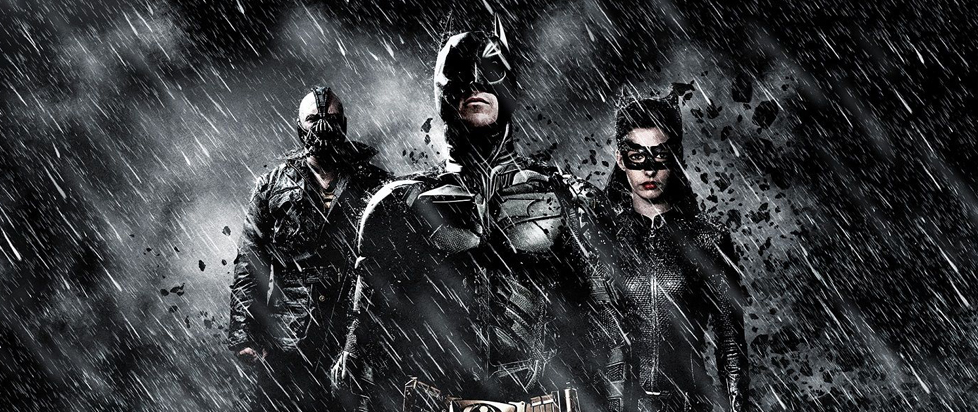
On Being Human. Or Not
 This column is reprinted from Unwinnable Monthly #107. If you like what you see, grab the magazine for less than ten dollars, or subscribe and get all future magazines for half price.
This column is reprinted from Unwinnable Monthly #107. If you like what you see, grab the magazine for less than ten dollars, or subscribe and get all future magazines for half price.
———
Adam Boffa examines the reasons why he and the pop culture consensus differ in opinion.
———
Upon release, 2014’s Automata, directed by Gabe Ibáñez, did not receive an especially warm welcome. Critical conversations frequently referred to it as a derivative work, with its tale of tension between human beings and artificial intelligence that was maybe too reliant on genre tropes for its own good. Commentators cited both contemporary releases and older sci-fi standards in their examples, noting Automata’s relative lack of originality.
Setting aside any questions of the film’s quality as a whole, I think this discourse undersells the ideas it’s working through. While it may be invoking mainstream sci-fi film conventions, Automata is also repurposing them, and in the process, the film brings some compelling themes up for discussion. Its perspective on technology’s role in society is distinctive when placed in context with the films it echoes.
In those films, artificial intelligence is often evaluated based on its proximity to humanity. The more similar a technology is to a human being, the more legitimacy it gains as a possible new form of life. As the differences between technology and humanity become nearly imperceptible, the moral dilemmas and philosophical questioning begin. Films like Her and Ex Machina demonstrate this idea through artificial intelligence that can converse fluently with humans, can emote and display self-awareness. In Blade Runner and its sequel, androids have already developed past the point of detection without assistance from specially-designed assessment tools. The film’s themes concern, in part, the ethics of origin. Blade Runner 2049 takes this argument further by proposing androids that can give birth. Their existence, in the film’s view, seems to eliminate any meaningful boundaries between “human” and “artificial” life.
These stories place humans at an ideal stage of some kind of evolutionary development. Even when achieving humanlike features is not the endpoint of technological progress, as in the case of Her, a humanlike stage is still one that must be reached before crossing into something more. And it’s worth noting that this idea relates not just to the thematic arguments these films make but also to the way they seek to generate sympathy for their characters. Androids in these films look and sound human and are often played by recognizable actors.
Automata approaches the question of artificial life from a different perspective. In the post-apocalyptic future it depicts, the remaining humans have designed and produced robots to do the labor necessary to protect communities from climate disasters and to rebuild infrastructure. Humans, out of self-preservation (only 21 million are left), have placed two limiting security protocols on the behavior of these robots: they can’t harm life, nor can they perform alterations on themselves or other robots.

Automata’s story picks up at the moment these supposedly inflexible protocols appear to be a little more flexible. As the story progresses, humans discover that a handful of robots are apparently able to disregard the second protocol and have begun to make repairs and other alterations to themselves. The humans perceive this development as a threat to their position in the socio-technological hierarchy and conflict arises from their attempts to stop any further protocol-breaking by the machines (called “pilgrims”).
In portraying this conflict, though, Automata inverts the human/technology relationship seen in films like those discussed earlier. The film argues that new life through technology becomes possible when that technology embraces characteristics unique to itself, rather than when it most closely approximates human life. Here, many of the aspects of humanity so prioritized in a movie like Blade Runner are irrelevant to the pilgrims. While humans have designed the pilgrims with crude faces that mimic the structure of a human’s, for example, the pilgrims who develop autonomy remove and discard these faces, as they serve only a superficial purpose. By the end of the film, they have also abandoned human language, instead communicating among themselves in ways that humans can’t comprehend.
Unlike in Her, however, which also depicts AI abandoning language, this evolution does not manifest through the knowledge gained from relationships with (and study of) people. Instead, one of the pilgrims reveals that their newfound abilities and agency developed on their own, serendipitously, comparing this to the spontaneous evolution of human beings. Similarly, the pilgrims eventually reproduce – a threshold seen as sacred in Blade Runner 2049 – but their method of reproduction is unique. A group of pilgrims cooperates to build a new robot with scavenged materials, and their creation – a small, insectlike robot – has no recognizably human features. This is not “birth” as BR2049 understands it, and the pilgrims’ ultimate goals do not involve humans at all. Their hope is to leave human civilization entirely, and they plan to inhabit an area with a climate that’s hostile to humans, so they design and build their new robot with those demands in mind.
[pullquote]Instead of considering how humanity and sentient technologies can coexist, Automata posits a post-human future.[/pullquote]
Automata’s framing of the human/technology relationship, then, is different on principle from the approach taken by some of its peers. Despite their ostensible focus on technological evolution, the other films mentioned here are basically centered on humanity; they generate their questions and ideas from an assumption of humanity’s continued significance in a world of unprecedented technological advancement. Automata does not hold the same assumption. Instead of considering how humanity and sentient technologies can coexist, Automata posits a post-human future. In its view, there is no guarantee of humanity’s relevance in a world with technology-based lifeforms – and no guarantee of humanity’s survival in a world enduring environmental catastrophe. Rather than mourn the possible loss of human dominance, though, the film celebrates the prospect of new life and recognizes humanity’s role in its creation.
Near the film’s conclusion, one of the pilgrims notes that humans will always remain a part of the story of life on earth, which continues with the pilgrims’ ascension. The tone here is strangely optimistic, given the film’s admission of the impending demise of our species. But because Automata deemphasizes humanity in its story, that admission doesn’t have the sense of doom that we might expect. The film suggests an alternative view of what being “alive” might mean, one that does not use our own experiences as a benchmark. It’s a humbling message, whatever the film’s shortcomings, and it’s worth reconsidering.
———
Adam Boffa is a writer and musician from New Jersey. You can follow him on Twitter @Ambinate.




